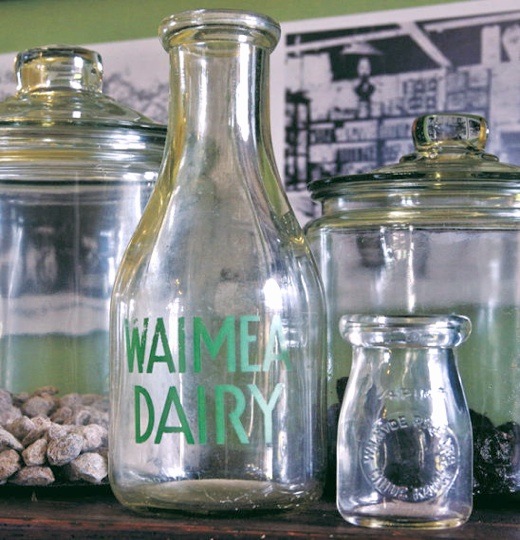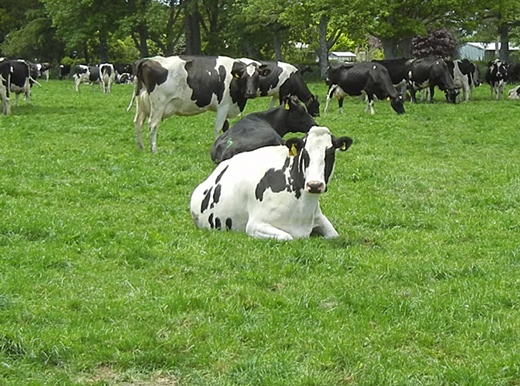SUBHEAD: Dairy using Concentrated Animal Feeding Operation in Mahaulepu is not sustainable farming.
By Juan Wilson on 16 September 2014 for Island Breath -
(http://islandbreath.blogspot.com/2014/09/disquiet-over-cafu-in-mahaulepu.html)

Image above: From (http://bloximages.chicago2.vip.townnews.com/thegardenisland.com/content/tncms/assets/v3/editorial/3/56/3562cfee-9ead-11e3-9699-0019bb2963f4/530d863355807.image.jpg).
"Disquiet over dairy drags on" (http://thegardenisland.com/news/local/disquiet-over-dairy-drags-on/article_8a0a961a-3bd5-11e4-a53c-8f33bb517e2a.html)
From the title of above TGI article from September 14th you might think that the people of Kauai upset by the possibility of a large scale Concentrated Animal Feeding Operationin Mahaulepu are just whiners that can never be satisfied. The fact of the mater is that this is a big deal for Kauai and needs all the scrutiny people are willing to give it.
Historically, the Hawaiian islands, like communities throughout mainland America, produced their own dairy products locally. Even big cities had their milk shipped in from nearby farms.
Kauai at one time had many dairies in operation. Many of the plantation operations on the island each had their own dairy. Incidentlally, the Westside Pharmacy, in Hanapepe, has a glass bottle collection with several local milk bottles brands from local dairies on display.
From 1848 until 1964 the Waimea Dairy operated on Kauai. By 1923, Waimea Dairy was milking 25 cows and selling 200 quarts daily to the public, with its employees filling positions such as office worker, herdsman, milk plant operator and deliveryman.
Before the Great Depression in the 1930's most dairy operations were family owned and operated. And those family farms were diverse in what they produced, dairy was just one aspect of their activities. Even as recently as 1970 the average herd size in America was under 20 cows.
Waimea Dairy sold its dairy facility (but not the land) to Meadow Gold in 1960, and Meadow Gold continued operating the dairy at that location makai of Kaumualii Highway between Waimea and Kikiaola Harbor until 1989.
Meadow Gold moved its operation to Moloaa in 1964 and produced much of Kauai's milk. The barns and meadows are still their - unused. In the economics of big commercial dairies an islandwide dairy operation was not profitable enough.
Whether it's profitable enough or not won't be the determination of the feasibility of many projects in the future when energy for transportation and equipment operation is considerably more expensive. In that future localization will hold sway. It will not make economic sense to depend on high energy consuming mechanization or transportation to "maximize profits". It will be a matter of getting along with what we need locally.
And this plan for the Hawaii Dairy Farms milking business is anything but local agriculture. It's an corporation planning to use 500 acres of Kauai for a feedlot/milking-barn for as many as 2,000 cows to provide raw product for its dairy product facility on Oahu. They will ship the feed here and ship the resulting milk back to Oahu for processing into finished dairy products (and then ship some of those finished products back here. Nutso!)
The Hawaii Dairy Farms website (http://www.hawaiidairyfarms.com/) trumpets:
Hawaii Dairy Farm's website also implies that Hawaii Dairy Farms will be a grassfed operation. That maybe true in the first phase. See (http://www.hawaiidairyfarms.com/news_posts/hawaii-dairy-farms-plans-for-phased-approach):
There is a major problem with island by island self dairy sufficiency in Hawaii. Oahu is over populated by factor of 4 or five times. What fertile, watered, 500 acres could they find on Oahu could be used by the Hawaii Dairy Farm corporation that would not generate greater resistance than they might find on sleepy Kauai?
You can bet if Hawaii Dairy Farm gets off the ground on Kauai they will be pushing for the resurrection of the Superferry in order to be taking tanker trucks of milk back to Oahu on a daily basis.
A economic and energy breakdown is underway now. The "Fracking Bubble" is bursting while the economy continues to languish.
We advise not planning any business that is built around large high-speed diesel powered military specked catamarans carrying feed and fertilizer filled tractor trailers one way, and sterilized refrigerated tank trucks full of milk the other.

Image above: New Zealand grass fed cows that appear on Hawaii Dairy Farms website from page that carries this disclaimer: "Photos represent similar grass-fed grazing models in New Zealand".
See also:
Ea O Ka Aina: Kauai Grassfed Dairy Fraud 4/13/14
.
By Juan Wilson on 16 September 2014 for Island Breath -
(http://islandbreath.blogspot.com/2014/09/disquiet-over-cafu-in-mahaulepu.html)

Image above: From (http://bloximages.chicago2.vip.townnews.com/thegardenisland.com/content/tncms/assets/v3/editorial/3/56/3562cfee-9ead-11e3-9699-0019bb2963f4/530d863355807.image.jpg).
"Disquiet over dairy drags on" (http://thegardenisland.com/news/local/disquiet-over-dairy-drags-on/article_8a0a961a-3bd5-11e4-a53c-8f33bb517e2a.html)
From the title of above TGI article from September 14th you might think that the people of Kauai upset by the possibility of a large scale Concentrated Animal Feeding Operationin Mahaulepu are just whiners that can never be satisfied. The fact of the mater is that this is a big deal for Kauai and needs all the scrutiny people are willing to give it.
Historically, the Hawaiian islands, like communities throughout mainland America, produced their own dairy products locally. Even big cities had their milk shipped in from nearby farms.
Kauai at one time had many dairies in operation. Many of the plantation operations on the island each had their own dairy. Incidentlally, the Westside Pharmacy, in Hanapepe, has a glass bottle collection with several local milk bottles brands from local dairies on display.
From 1848 until 1964 the Waimea Dairy operated on Kauai. By 1923, Waimea Dairy was milking 25 cows and selling 200 quarts daily to the public, with its employees filling positions such as office worker, herdsman, milk plant operator and deliveryman.
Before the Great Depression in the 1930's most dairy operations were family owned and operated. And those family farms were diverse in what they produced, dairy was just one aspect of their activities. Even as recently as 1970 the average herd size in America was under 20 cows.
Waimea Dairy sold its dairy facility (but not the land) to Meadow Gold in 1960, and Meadow Gold continued operating the dairy at that location makai of Kaumualii Highway between Waimea and Kikiaola Harbor until 1989.
Meadow Gold moved its operation to Moloaa in 1964 and produced much of Kauai's milk. The barns and meadows are still their - unused. In the economics of big commercial dairies an islandwide dairy operation was not profitable enough.
|
Whether it's profitable enough or not won't be the determination of the feasibility of many projects in the future when energy for transportation and equipment operation is considerably more expensive. In that future localization will hold sway. It will not make economic sense to depend on high energy consuming mechanization or transportation to "maximize profits". It will be a matter of getting along with what we need locally.
And this plan for the Hawaii Dairy Farms milking business is anything but local agriculture. It's an corporation planning to use 500 acres of Kauai for a feedlot/milking-barn for as many as 2,000 cows to provide raw product for its dairy product facility on Oahu. They will ship the feed here and ship the resulting milk back to Oahu for processing into finished dairy products (and then ship some of those finished products back here. Nutso!)
Production is shifting to farms with at least 500 cows... The number of farms in this largest size class more than doubled between 2000 and 2006... |
The Hawaii Dairy Farms website (http://www.hawaiidairyfarms.com/) trumpets:
"We believe that Hawaii's milk should come from Hawaii."I think that should be amended. Not only should "Hawaii's milk should come from Hawaii", but
"Kauai's milk should come from Kauai."
"Oahu's milk should come from Oahu."
Hawaii Dairy Farm's website also implies that Hawaii Dairy Farms will be a grassfed operation. That maybe true in the first phase. See (http://www.hawaiidairyfarms.com/news_posts/hawaii-dairy-farms-plans-for-phased-approach):
But that is just phase one. They go on to say:
"The first phase starts with 650-699 cows and allows the pasture system to fully establish. The size of the herd in phase one equates to roughly 1.5 cows per acre of the farm’s 578 acres"
The submitted plan includes facilities designed for the original proposed scale of up to 2,000 milking cows to accommodate for phase two, which will be part of a future application for a Concentrated Animal Feeding Operation (CAFO) permit.This scale of dairy farming will double all dairy production in Hawaii. Doubling production may be a valuable thing to do, but it should be on an island by island basis.
The American dairy industry annually produces about 20 billion gallons of raw milk, which is processed and sold as butter, cheese, ice cream, and fluid milk. This amounts to about $27 billion in sales each year. The production of large amounts of milk has called for changes that affect the animals' health, including the use of drugs, mechanization, and factory-like housing conditions. Most dairy cows are raised in concentrated animal feeding operations (CAFOs); about 10 percent of those are considered large CAFOs, each with more than 700 dairy cattle. |
There is a major problem with island by island self dairy sufficiency in Hawaii. Oahu is over populated by factor of 4 or five times. What fertile, watered, 500 acres could they find on Oahu could be used by the Hawaii Dairy Farm corporation that would not generate greater resistance than they might find on sleepy Kauai?
You can bet if Hawaii Dairy Farm gets off the ground on Kauai they will be pushing for the resurrection of the Superferry in order to be taking tanker trucks of milk back to Oahu on a daily basis.
A economic and energy breakdown is underway now. The "Fracking Bubble" is bursting while the economy continues to languish.
We advise not planning any business that is built around large high-speed diesel powered military specked catamarans carrying feed and fertilizer filled tractor trailers one way, and sterilized refrigerated tank trucks full of milk the other.

Image above: New Zealand grass fed cows that appear on Hawaii Dairy Farms website from page that carries this disclaimer: "Photos represent similar grass-fed grazing models in New Zealand".
See also:
Ea O Ka Aina: Kauai Grassfed Dairy Fraud 4/13/14
.
No comments :
Post a Comment